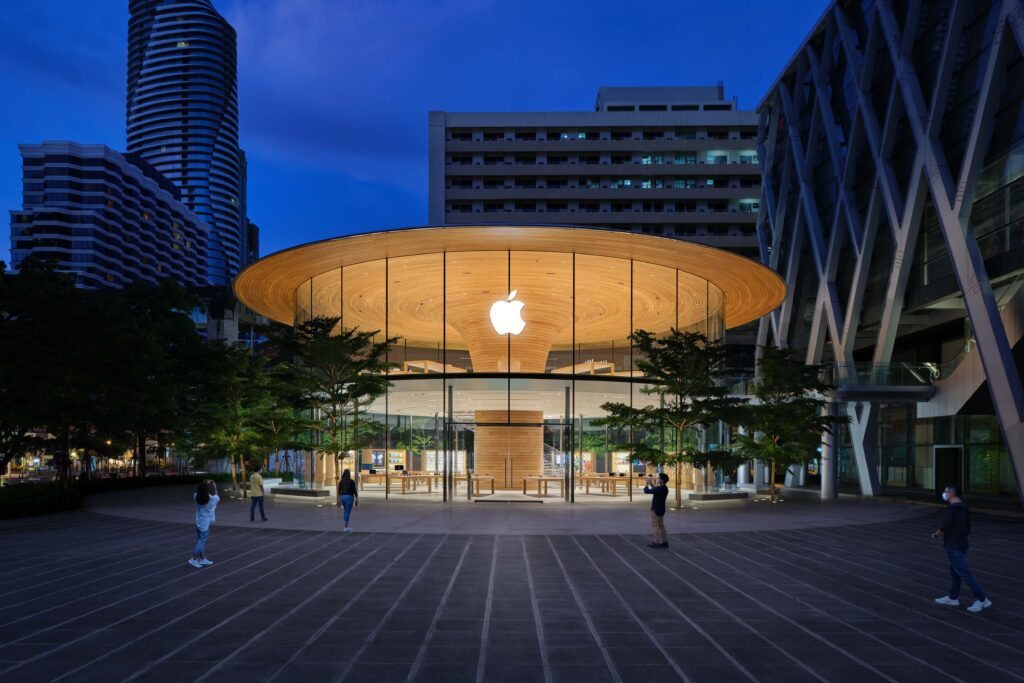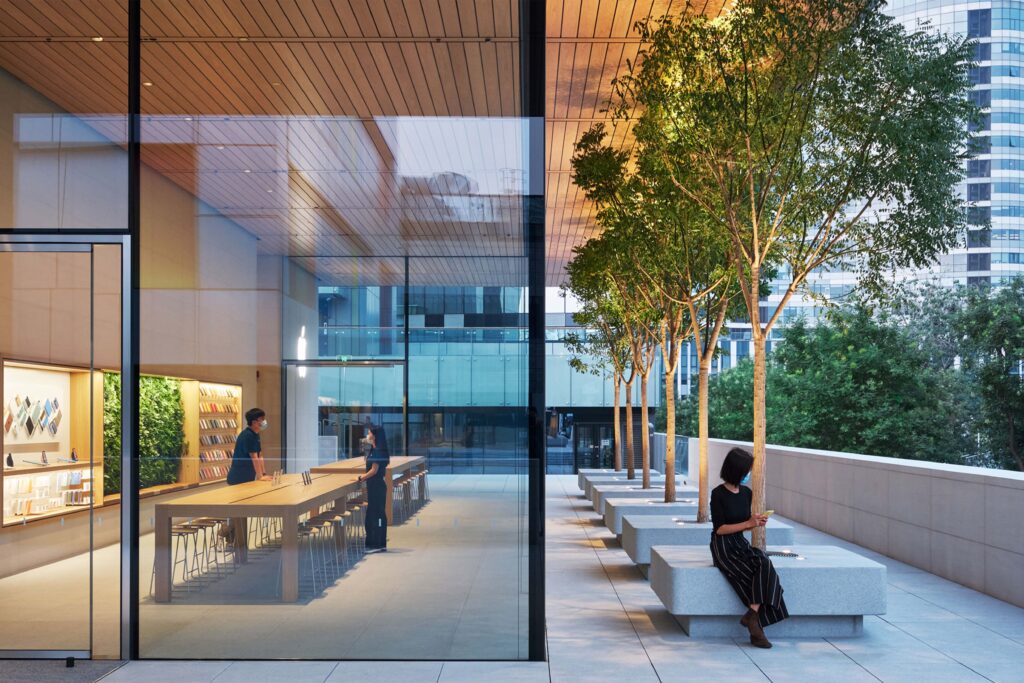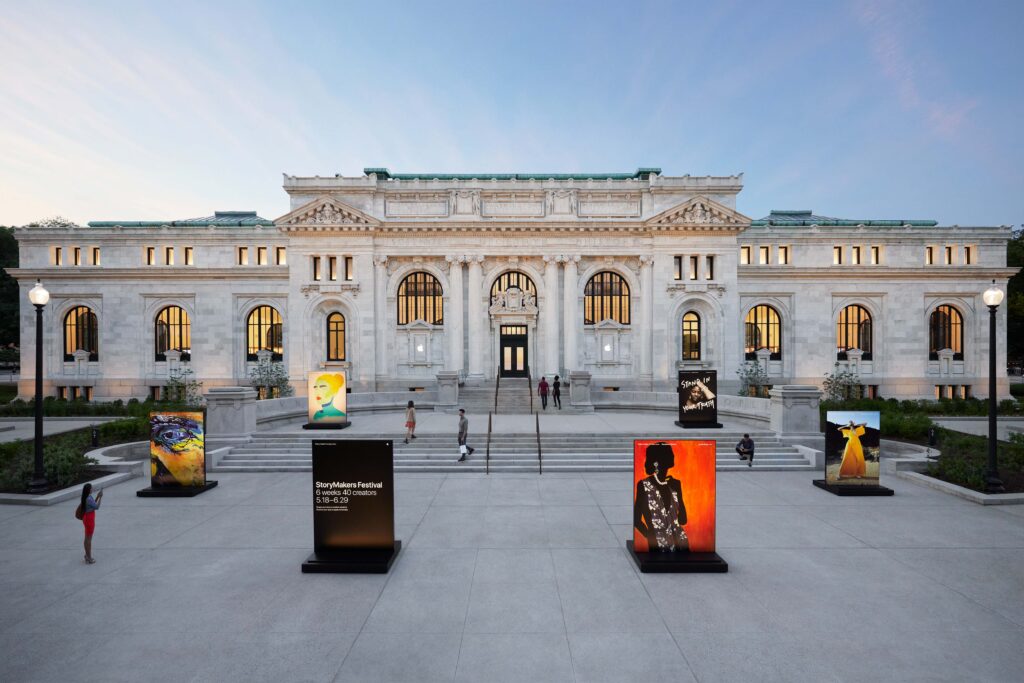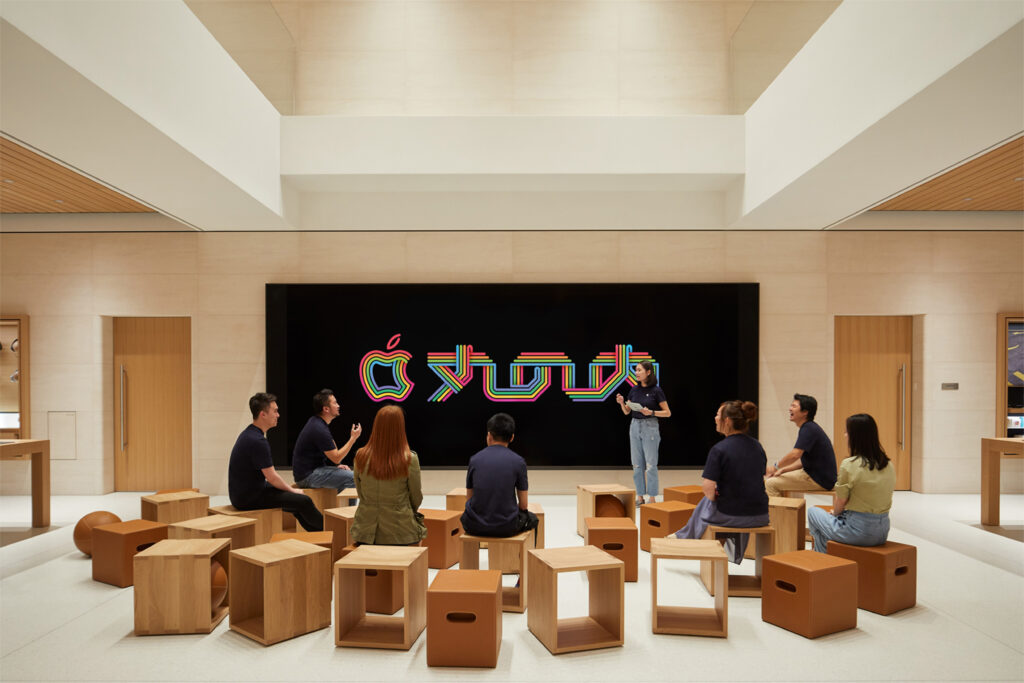Introduction
Luxury Redefined
The Power of Place
In the late 1990s, Apple was at the precipice of a breakthrough.
Fresh from his return to the company in 1997, Steve Jobs had launched a sleek new product – the iMac – that brought the brand back from the brink of doom. But he faced a problem: iMacs were getting lost in a sea of uninspired retail experiences. At the time, Apple relied on big-box electronics stores, where their computers sat among a jumble of beige PCs, with salespeople who barely understood the difference between a Mac and a microwave.
Jobs knew that Apple’s vision needed to be showcased in the same sophisticated approach he had toward his products, which leveraged design to create desirability, a novelty among technology merchandising at the time.
The solution, Jobs understood, lay in retail – retail as it has never been done before. Apple wouldn’t just sell computers; it would sell an experience.
In 1999, Jobs and a small team, including former Target executive Ron Johnson, began secretly prototyping what an Apple Store could be. Tapping San Francisco design firm Eight Inc., they built a mock store inside a warehouse in Cupertino, testing every detail, from the height of display tables to the way customers would interact with products. The guiding principle was simplicity. Products would be out in the open, inviting hands-on exploration.
When the first two Apple Stores opened in 2001 – located in Tysons Corner, Virginia, and Glendale, California – these stores weren’t just places to shop; they were temples to technology. More than a thousand people queued outside of the Virginia location, a well-lit, pristine space with fixtures in light wood and brushed steel. Apple products were displayed on sprawling tables and platforms along the wall, each section thoughtfully divided by product.
In the following years, Apple took its design-led brick-and-mortar strategy and amplified it. Today, Apple’s hundreds of stores have become regional landmarks. No two stores are identical, but all share a signature aesthetic: clean lines, glass facades, and an emphasis on natural materials like wood and stone.
Take, for example, Apple Central World in Bangkok. Nestled in the heart of the iconic Ratchaprasong intersection, its perfectly curved façade and cantilevered tree canopy roof dissolve the boundary between inside and out, echoing the surrounding ring of trees. In Beijing, Apple Sanlitun features a porous building enveloped by a vast sweeping overhang that shields visitors from monsoon rains and summer sun, creating a welcoming place to pause and gather. Apple Carnegie Library in Washington D.C. adopts a different approach, revitalising a neglected Beaux-Arts landmark, restoring its grandeur and reactivating its original southern entrance with a grand public plaza that now hosts concerts and events. It’s an effective playbook: in its fiscal 2024 year, Apple generated $391 billion in sales.
Apple redefined the power of luxury retail. Even as commerce becomes growingly digitalised, the value of an in-person experience is as potent as ever – especially as luxury faces significant headwinds in the year ahead.
Today’s Challenging Landscape for Luxury
Financial Backdrop
Experienced retail leaders from across all sectors and regions of the world confirm that they have never known a more challenging, more competitive and fast-moving time in retailing, a sentiment that frames the current environment for luxury.
After a post-pandemic boom, global sales of high-end goods stagnated in 2024, with some markets experiencing their first signs of stagnation in years. According to Bain & Company, global luxury spending totaled €1.48 trillion last year, a decrease of about 1 percent to 3 percent at current exchange rates compared to 2023 — a stark contrast to the double — digit growth seen just a few years ago. In China, deceleration was even more dramatic: the Chinese luxury market declined 18 percent to 20 percent in the same period.
With a global trade war continuing to unfold, analysts do not anticipate a return to growth, at least not in luxury, in 2025. Additionally, McKinsey reports that more than 60 percent of consumers are now more selective in their discretionary spending due to inflationary pressures, including tariff-related price increases. But it’s not just a difficult economy or geopolitical uncertainty that has slowed down spending.
SHIFTING CONSUMER BEHAVIOUR
At the same time, luxury is experiencing an identity crisis – with an increasing divide between mass-market luxury and true exclusivity. The democratisation of high fashion, fueled by social media, influencer marketing, and affordable access to luxury items via resale, has made once-exclusive brands seem overexposed.
“More recently, the sector has gone through a bit of a hiccup as demand suffered from what we called ‘greedflation,’ the idea that post Covid, many brands went too high too quickly in terms of price points and this, combined with a lack of creativity, has hit demand […] We argue that is now evolving again as brands come out with product ranges that enable them to rebuild stepping stones for the aspirational consumer who had been temporarily priced out.”
“There is the inescapable fact that all of us as consumers have come to realise that we are in control when it comes to finding and buying the things we need and want. The consumer is in complete control of where, when and how they want to shop.”
Today’s luxury consumer demands more than a monolithic brand identity. Personalisation, niche exclusivity, and unique cultural affiliations have driven fragmentation in the market. Shoppers no longer seek just heritage; they want a brand that aligns with their personal identity and values. As of 2024, Bain estimates that Gen Z alone accounted for about 20 percent of global luxury spending, while Gen Z and Millennials combined are projected to contribute around 70 percent of all luxury expenditures by 2025.
A NEED FOR RETAIL TRANSFORMATION
In the last 15 years, the convenience and competitive pricing of online shopping, led by Amazon, significantly disrupted all of brick-and-mortar retail. Consumers, especially younger generations, increasingly favoured direct-to-consumer brands, fast fashion, and specialty retailers over the one-size-fits-all department store experience.
The financial crisis of 2008 accelerated these challenges, leading to store closures and bankruptcies. A major issue across the sector was that malls, department stores and traditional retailers had failed to modernise their retail environments. Many relied on outdated layouts, impersonal customer service, and slow inventory turnover, making them less appealing compared to emerging competitors.
“Retailing – across all sectors, not just luxury – relies on emotion. Consumers have to be attracted to the brand and increasingly the lifestyle or values they evoke. Above all, it is about creating experiences and particularly in physical space.”
A return of experience
Social Isolation
Today, the rise of digital shopping has brought unparalleled convenience, but it has also led to a retail experience that is increasingly transactional and devoid of human connection.
Online shopping, for all its advantages, has created a paradox of choice. Shoppers are bombarded with countless options, leading to decision fatigue and a longing for curated, guided experiences. Studies indicate that more than 70 percent of online shopping carts are abandoned, with respondents citing indecision as the leading cause, overwhelmed by the options or information presented to them.
Beyond the effects on retailers, consumers in general are sick of – and physically sick from – interfacing with technology. Younger adults are particularly concerned about their screen time, for instance. According to a 2023 Deloitte survey, 51 percent of Gen Z and Millennials agreed with the statement, “I’m concerned that my device usage may negatively impact my physical well-being.” 47 percent said they are concerned technology has affected their mental health.
In this landscape, the principles that made department stores revolutionary – a focus on atmosphere, discovery, and social engagement – are precisely what can set physical retail apart in the modern era.
A robust real estate market
Meanwhile, global demand for brick-and-mortar retail in prime destinations is the most competitive it’s been in recent memory, signifying the importance of the physical shopping experience. In 2024, new store openings for luxury brands increased 12 percent, with China accounting for 40 percent of that growth, according to a Savills report. Despite a pullback in the luxury sector in 2024, brands including Loewe, Chanel, Alaïa, Lemaire, Louis Vuitton and Cartier have all opened new locations in the last two years.
Global retail rents have steadily bounced back since hitting a low in 2020, with demand for space in prime locations remaining robust in the fourth quarter of 2024 despite subdued consumer sentiment in a number of major markets and lackluster global spending growth over the last year. Although retail bankruptcies have risen in the US and Europe, availability of prime retail spaces is limited and new development or vacancies coming onto the market is being quickly absorbed. Retailer activity also remains healthy in high-growth and tourism-oriented markets in Asia Pacific. Cities that saw rents accelerating coming into 2025 include Sydney, Paris, Bengaluru, Dubai, Delhi, Mumbai, Milan, Madrid, Seoul, and Berlin, according to JLL data.
For brands and retailers, a competitive real estate market signals the health of physical commerce. Whereas intensifying contention for the world’s best retail real estate has created higher cost levels for store openings. As a result, the standard of efficacy for each store is higher than ever, not only in terms of productivity but also in creating a sense of desirability – giving shoppers a reason to visit a store as a cultural destination more than just a place to buy goods.
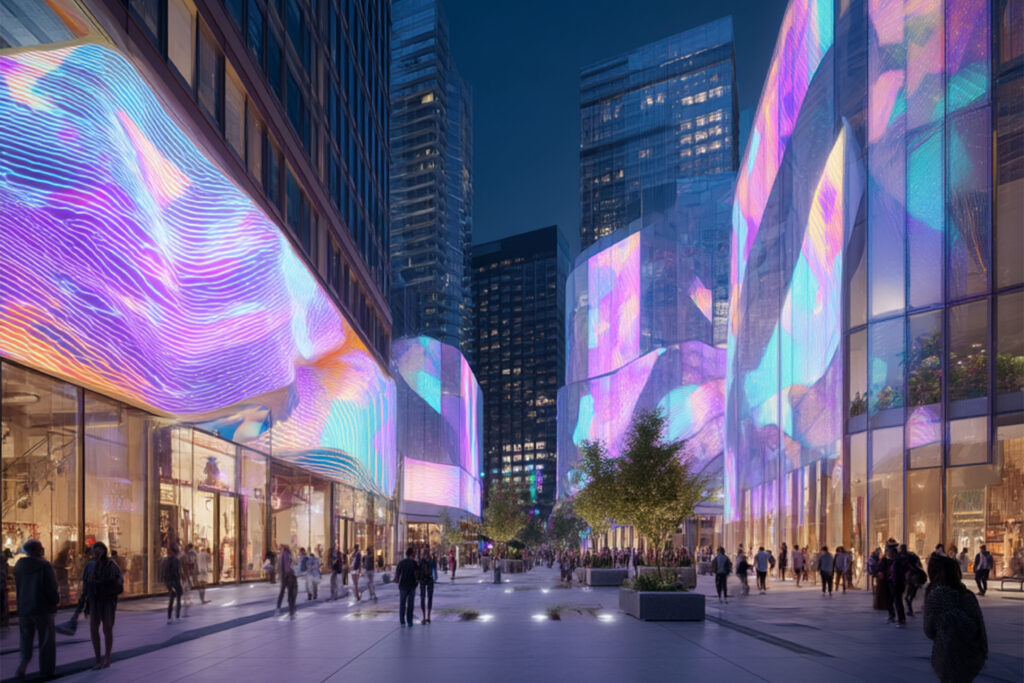
AI Imagery – Source: Sybarite.
DESIGN REIGNS SUPREME
The most effective strategy for creating a cultural destination is rooted in experiential luxury: hospitality concepts, food and beverage offerings and investing in flagship retail. The power of retail has always been rooted in its ability to use design and a sense of space to drive engagement – and ultimately sales. Long before the rise of e-commerce, retailers understood that the physical environment played a critical role in shaping consumer behavior. Thoughtful store layouts, striking architectural elements, and sensory experiences have long been tools to captivate shoppers and foster brand loyalty.
Shifting our lens from the West – where department stores and luxury brands were born – to the fast-growing markets of Asia and the Middle East, we see a bold new chapter unfolding. Here, retailers are not just responding to change; they’re driving it. With visionary thinking, they are breaking down boundaries between retail and adjacent industries, pushing the limits of what a physical retail experience can be.
A prime example is SKP Beijing, rebranded and reopened in 2012. It quickly became a benchmark for luxury retail in China and gained global recognition – not only for its exceptional sales per square foot but for creating what many call an ‘immediate heritage.’ Through a meticulously curated brand mix, strategic floor planning, and immersive sensory design, SKP redefined what a department store could offer today’s emotionally and experientially-driven consumer.
Just across the road, SKP-S Beijing opened a few years later as SKP’s alter ego – a bold, future-facing, experience-first destination that reimagined luxury for a new generation. Unlike traditional department stores, SKP-S speaks the language of innovation, experimentation, and cultural relevance, positioning ‘experience per square metre’ as its central design principle.
By 2025, SKP and SKP-S will have established retail destinations in four major Chinese cities – each tailored to its unique location and local culture. Throughout this journey, Sybarite has had the privilege of partnering with SKP as its architectural and retail planning collaborator for over a decade, helping bring this transformative vision to life.
At Sybarite, we’ve been fortunate to work with such a forward-thinking client and to witness first-hand the evolution of department stores into cultural, emotional, and commercial landmarks. Following our 2019 publication ‘The Future of Luxury,’ we believe the current moment – shaped by rapid shifts across social, political, economic, cultural, and technological domains – calls for a renewed perspective on retail. Now is the right time to both reflect and look ahead, to rethink what retail can and should become.
Read our 2018/19 Luxury Report
This report is our contribution to that conversation. We’ve invited voices from media, trend forecasting, strategic consultancy, real estate analysis, and brand and department store operations to share their insights. We explore the enduring value propositions of retail’s past and spotlight pioneering formats that point toward the future – analysing them from business, strategic, and design perspectives.
Our hope is that this report, in its own small way, helps pave the way toward a more customer-centred, experience-driven, and future-ready retail landscape.
